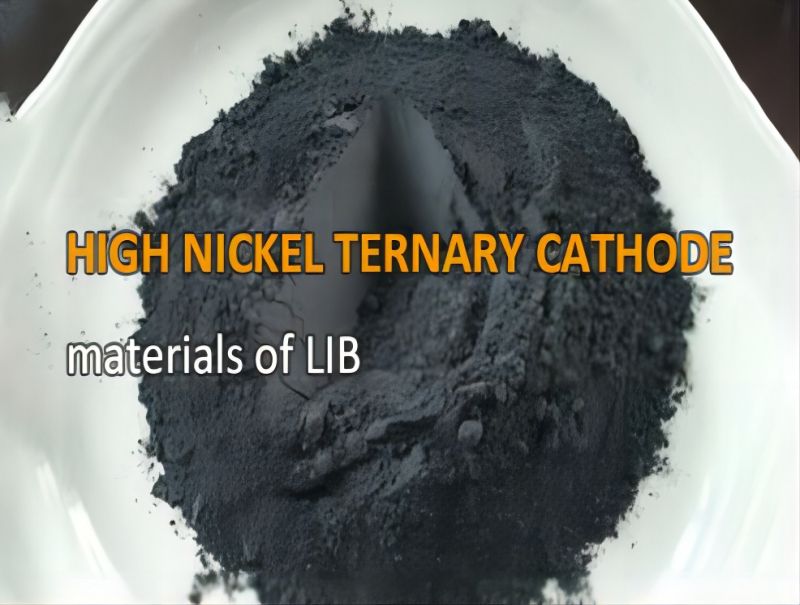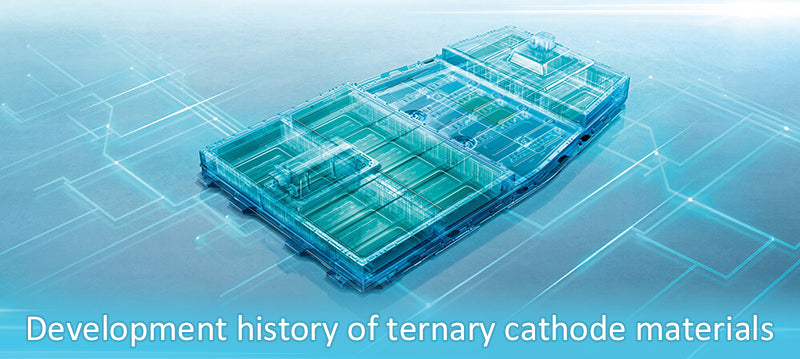
Main content:
- Development history of ternary cathode materials
- Research progress and challenges of high nickel ternary cathode materials
- Research progress of high-nickel ternary cathode materials
- Problems of high-nickel ternary layered cathode materials
- Modification strategies for high-nickel ternary cathode materials
- Summary and outlook
With the gradual expansion of the application of lithium-ion batteries in the field of new energy vehicles, the cruising range has become a key factor restricting the development of new energy vehicles. Improving the energy density of lithium-ion batteries is an effective way to solve the anxiety of lithium ion battery life.
High nickel ternary cathode materials have relatively high capacity, low cost and relatively good safety, it is considered to be one of the most promising cathode materials for high specific energy lithium-ion batteries. However, the cycling stability and thermal stability of the ternary layered materials decreased significantly with increasing Ni content. Compared with olivine and spinel structure compounds, high-nickel ternary cathode materials have a higher specific capacity and can better meet the needs of high energy density.
Among them, Li[Ni1-x-yCoxMny]O2 (NCM) and Li[Ni1-x-yCoxAly]O2 (NCA) cathode materials have long been considered as candidate cathode materials for electric vehicles due to their low cost and high specific capacity.
The study found that the key to improving the discharge capacity of NCM and NCA ternary cathode materials is to increase the proportion of nickel content, but too high nickel content will reduce the cycle stability of cathode materials, especially high-nickel ternary layers with a nickel content of more than 80%.
The mechanical stress caused by the anisotropic volume change of the positive electrode material during the cycle will lead to microcracks inside the material, which increases the contact area between the electrode active material and the electrolyte on the one hand and causes side reactions.
On the other hand, the high oxidation state Ni4+ will generate Ni-O-like compounds on the surface of the microcracks of the positive electrode material, resulting in a significant decrease in the stability and rate performance of the positive electrode material during cycling.

Development history of ternary cathode materials
Due to the inevitable shortcomings of single transition metal layered oxides, the actual discharge specific capacity of LiCoO2 layered materials is low, and the structural stability and safety performance of LiNiO2 and LiMnO2 layered materials are poor, so it is difficult to use them in the field of power batteries.
For commercial applications, with the continuous deepening of research on cathode materials, single transition metal layered materials have gradually developed into ternary layered cathode materials.
In 1999, scientists prepared Li[Ni1-x-yCoxMny]O2 (0≤x≤0.5, 0≤y≤0.3) ternary layered cathode material containing Ni, Co, and Mn. The system material combines the respective advantages of LiNiO2, LiCoO2 and LiMnO2 three layered materials, which greatly improves the specific capacity and cycle stability of the material while reducing the cost, and has a very broad development prospect.
In 2001, scientists prepared Li[Ni1/3Co1/3Mn1/3]O2 ternary layered cathode material (NCM 333) by hydroxide co-precipitation method, which showed a reversible specific capacity of 160 mAh/g, good cycle performance and safety performance. The report of NCM 333 ternary material immediately attracted the attention of researchers, and the NCM ternary cathode system entered a period of rapid development and gradually realized commercialization.
In 2003, scientists found that the Li[Ni1-x-yCoyMnx]O2 ternary layered material has a similar structure to LiCoO2, LiNiO2 and LiMnO2 layered materials, which is an α-NaFeO2 structure and belongs to the R-3m space group.
Ni, Co, Mn The three elements randomly occupy the 3b position to form a transition metal layer, Li occupies the 3a position and alternately arranges with the transition metal layer, and has a two-dimensional lithium ion transport channel.

Research progress and challenges of high nickel ternary cathode materials
① Research progress of high-nickel ternary cathode materials
The higher the content of Ni in the ternary material, the greater the reversible specific capacity of the material. In order to meet the demand for high energy density of lithium-ion batteries, the proportion of active element nickel in the ternary layered material has been increasing in recent years, and the cobalt content has gradually increased.
Reduced, the capacity of the positive electrode material is increased while the cost is reduced. At present, the NCM811 ternary lithium battery has achieved commercial application, and its market share in the field of power batteries has rapidly expanded, and its system energy density can reach 180-200 Wh/Kg.
However, compared with traditional fuel vehicles, cruising range is the biggest bottleneck restricting the development of electric vehicles, and NCM 811 cathode materials are still not enough to meet the growing demand for energy density of power batteries. Therefore, in order to further increase the energy density of lithium-ion batteries, the nickel content in the high nickel ternary cathode material is increased to more than 80%.
② Problems of high-nickel ternary layered cathode materials
High nickel ternary cathode materials have higher initial discharge capacity, but they also bring a series of problems:
- cation mixing;
- structural degradation;
- microcracks;
- surface side reactions;
- thermal stability.
There is a trade-off between the specific capacity of the ternary layered cathode material and the capacity retention and thermal stability. With the increase of nickel content and the decrease of cobalt/manganese content, high nickel ternary cathode transition metal oxides provide higher specific capacity, but at the expense of capacity retention and thermal stability.
The main reason is that high nickel ternary cathode materialscontent will lead to an increase in the degree of cation mixing in the material, and high nickel ternary cathode materials are more likely to undergo irreversible phase transitions during electrochemical cycling, and the volume anisotropy changes greatly, causing material structure degradation, formation of microcracks, occurrence of side reactions, and a series of problems such as gas generation, which lead to a reduction in the cycle life of lithium-ion batteries.

Modification strategies for high-nickel ternary cathode materials
In order to solve the above problems of high nickel ternary cathode materials, strategies to solve the problems of high nickel ternary cathode materials and improve their electrochemical performance mainly include surface coating, element doping, single crystal structure and concentration gradient design, etc.① Surface coating
Surface coating is one of the effective strategies to improve the thermal stability and structural stability of cathode materials. Through this method, a protective layer can be formed on the surface of electrode materials, which has many beneficial effects on electrode materials, including improving the ionic conductivity of cathode materials.
And it can also help promote electron transfer and lithium ion diffusion, stabilize surface structure, prevent direct contact between positive electrode material and electrolyte, and prevent gas evolution, etc.
② Element doping
Element doping is an effective strategy to reduce the degree of Li/Ni disorder and improve structural stability in Ni-rich ternary cathode materials. Element doping improves the structural stability of the nickel-rich ternary cathode by introducing a small amount of dopant to replace atoms in the lattice. Element doping can be divided into cation doping and anion doping according to the type of element.③ Single crystal structure
Most nickel-rich ternary layered materials exist in the form of polycrystalline secondary particles consisting of many primary particles that can generate intergranular cracks due to anisotropic shrinkage and expansion during electrochemical cycling, especially the secondary particle hierarchical structure with grain boundaries will produce more serious microcracks and accelerate the side reactions at the electrode-electrolyte interface.
Microcracks and rupture of particles in high nickel ternary cathode polycrystalline materials are one of their common failure mechanisms, which will lead to side reactions on the surface of active materials isolated from the electrolyte, resulting in irreversible capacity loss. However, high nickel ternary cathode single-crystal materials usually exhibit stronger mechanical strength and good electrochemical performance.
④ Concentration gradient structure design
Concentration gradient structure design is one of the effective strategies to improve the structural stability of high nickel ternary cathode layered materials. The design idea of concentration gradient structure originally originated from the core-shell structure, which mainly includes core-shell structure, shell concentration gradient, full concentration gradient and double-slope concentration gradient design strategy.
The core idea of the concentration gradient design is to use a ternary layered oxide with a high-Ni content as the inner component and a stable layered oxide with a lower Ni content as the outer component, both of which provide high capacity and structural stability, respectively.

Summary and outlook
Modification strategies for high nickel ternary cathode materials, including surface modification, element doping, single crystal structure, and concentration gradient design.
The above modification strategies have their own advantages and disadvantages:
- Element doping is beneficial to improve the structural stability of the material and cycle performance, but the introduction of inactive components leads to a decrease in the proportion of active components in the positive electrode material, which is not conducive to the realization of high specific capacity.
- The surface coating is similar to element doping, which will increase the inactive weight in the positive electrode material, resulting in a decrease in the specific capacity of the positive electrode material.
- Due to its stable structure and high mechanical strength, single crystal materials have very excellent thermal stability and cycle performance, but the preparation cost of single crystal materials is relatively high, and it does not show obvious advantages in terms of actual specific capacity and rate performance.
- The high nickel ternary cathode layered oxide granular material with a concentration gradient structure has excellent cycle performance and thermal stability, but its preparation process is relatively difficult, and the co-precipitation parameters are difficult to control during the preparation process.
Related article: nickel-metal hydride vs lithium ion AA batteries, nickel metal hydride battery, top 10 lithium battery ternary material companies